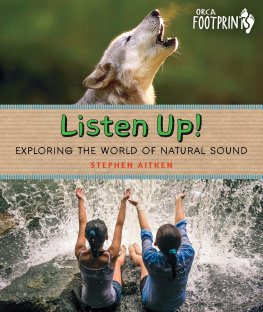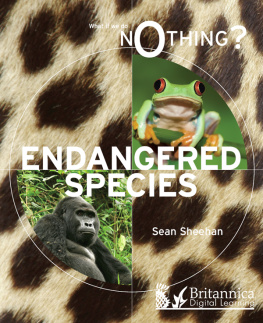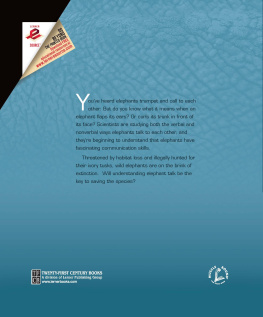THE SOUNDS OF LIFE
THE SOUNDS OF LIFE
HOW DIGITAL TECHNOLOGY IS BRINGING US CLOSER TO THE WORLDS OF ANIMALS AND PLANTS
KARENBAKKER
PRINCETON UNIVERSITY PRESS
PRINCETON AND OXFORD
Copyright 2022 by Karen Bakker
Princeton University Press is committed to the protection of copyright and the intellectual property our authors entrust to us. Copyright promotes the progress and integrity of knowledge. Thank you for supporting free speech and the global exchange of ideas by purchasing an authorized edition of this book. If you wish to reproduce or distribute any part of it in any form, please obtain permission.
Requests for permission to reproduce material from this work should be sent to permissions@press.princeton.edu
Published by Princeton University Press
41 William Street, Princeton, New Jersey 08540
99 Banbury Road, Oxford OX2 6JX
press.princeton.edu
All Rights Reserved
ISBN 9780691206288
ISBN (e-book) 9780691240985
Version 1.0
British Library Cataloging-in-Publication Data is available
Editorial: Alison Kalett and Hallie Schaeffer
Production Editorial: Natalie Baan
Text Design: Karl Spurzem
Jacket/Cover Design: Amanda Weiss
Production: Jacquie Poirier
Publicity: Kate Farquhar-Thomson and Sara Henning-Stout
Copyeditor: Jennifer McClain
Jacket images from top to bottom: European pond turtle from Deutschlands Amphibien und Reptilien by Bruno Drigen, 1809. Bees and Lilies, illustration from Stories of Insect Life by William J. Claxton, 1912, Private Collection / Bridgeman Images. Group of Corals, illustration from Science for All by Robert Brown, 1877. Patulous gorgonia or Flat Gorgonia illustration from The Naturalists Miscellany (17891813) by George Shaw. Medical botany plant / Raw Pixel. Tomato plant, 16491659, Hans-Simon Holtzbecker. Soundwave by Marina / Adobe Stock.
For the Peace River
Listening to wild places, we are audience to conversations in a language not our own.
ROBIN WALL KIMMERER, BRAIDING SWEETGRASS
CONTENTS
THE SOUNDS OF LIFE
INTRODUCTION
Compared with our cousins on the Tree of Life, humans are poor listeners.
The deepest infrasound is generated by our planet itself. If you could tune into the Earths infrasound, you might hear the rumblings of calving icebergs, the howl of a volcano, or the roar of a typhoon halfway around the world.
The planets infrasonic chorus is continuously sounding all around you. Many animalsrock doves and snakes, tigers and mountain beaversare able to hear these low-frequency sounds, but not humans.
At the other end of the spectrum, above the upper threshold of human hearing, lies the ultrasonic: high-frequency sounds that vibrate too quickly for us to hear. A surprisingly diverse array of speciesmice and moths, bats and beetles, corn and coralsemit ultrasonic sounds imperceptible to humans.
Still other species use ultrasound to visualize their world: to navigate, find mates, and follow prey. By using what is known as echolocation, bats and toothed whales create images of their surroundings by sending out beams of ultrasound and analyzing the returning echoes. Biosonar (as echolocation is also known) functions somewhat like an acoustic flashlight, honed by evolution to be as accurate as our finest medical devices. Simpler forms of echolocation are also used by cave swiftlets and oil birds, nocturnal shrews and rats; they, too, see the world through sound. Attuned humans can occasionally hear the subtle clicks at the lower end of animal echolocation; rarely, blind people even develop the ability to echorange themselves. But for most of us, even the loudest ultrasonic sound blown directly into our ears would feel like nothing more than an empty, ghostly breath of wind.
As Blackfoot philosopher Leroy Little Bear says, The human brain is like a station on the radio dial; parked in one spot, it is deaf to all the other stations the animals, rocks, trees, simultaneously broadcasting across the whole spectrum of sentience. Our physiologiesand perhaps our psycheslimit our capacity to listen to our nonhuman kin. But humanity is beginning to expand its hearing ability. Digital technologies, so often associated with our alienation from nature, are offering us an opportunity to listen to nonhumans in powerful ways, reviving our connection to the natural world.
In recent years, scientists have begun installing digital listening devices in nearly every ecosystem on the planet, from the Arctic to the Amazon. These microphones are computerized, automated, and networked with digital sensors, drones, and satellites so powerful they can hear a mother whale whispering to her calf in the depths of the ocean. Researchers have attached tiny microphones to honeybees and turtles, and affixed listening posts to coral reefs and trees. When interconnected, these listening networks may stretch across entire continents and ocean basins. Combined, these digital devices function like a planetary-scale hearing aid: enabling humans to observe and study natures sounds beyond the limits of our own sensory capabilities.
This book tells the stories of the scientists who are using these digital technologies to decode the hidden world of nonhuman sound, and the surprising sounds they are hearing. Recent scientific breakthroughs have revealed that a vast array of species makes an astonishing assortment of sounds, mostly beyond the range of human hearingand so, until recently, unsuspected and unappreciated. (In writing this book, I surveyed research on more than 1,000 species, a small fraction of the scientific findings on bioacousticsthe technical term for the science of listening to nonhuman organisms.) Dolphins and belugas, mice and prairie dogs use unique vocalizations (like signature whistles) to refer to one another, much as we do with individual names. Baby bats babble at their mothers, who speak back to their young in motherese, just like humans do. Turtle hatchlingspreviously thought to be mutecoordinate the moment of their birth by calling to one another through their shells. Animals use sound to warn, protect, and lure one another; to teach, amuse, and name one another.
Carefully listening to the nonhuman world reveals complex communication in a broad range of species and challenges the claim that humanity, alone, uniquely possesses language. These claims might seem plausible when discussing primates or birds. But what digital technologies reveal is the vast extent of sonic communication across the natural world. Using digital bioacoustics, scientists have documented the ability of species without ears, or any apparent means of hearing, to interpret and respond to complex information conveyed through sound. When dispersed in the open ocean, fish and coral larvae (creatures only a few millimeters in size, with no central nervous system) distinguish the sounds of their home reefs from the cacophonous ocean, and then swim back home to settle. Plants emit distinct ultrasonic noises when dehydrated or distressed. In response to the sound of buzzing bees, flowers flood with sweetened nectar, as if in anticipation. The Earth is in continuous conversation. Now, digital technologies provide a new way for humanity to listen to the vivid soundscapes all around us, opening our ears to the resonant mystery of nonhuman sound.
Resonant Earth
The scientific breakthroughs explained in this book primarily occur in two fields of study: bioacoustics and ecoacoustics. Together, these scientific disciplines enable humans to have digitally mediated access to the hidden conversations ongoing across the natural world, even in the remotest places on Earth. As explored in the chapters that follow, this dramatically enhances our ability to monitor organisms and ecosystems and detect environmental change. Scientists are also experimenting with the use of bioacoustics and ecoacoustics to restore ecosystems; natures sounds, they have learned, can be used to regenerate the health of plants and animals, including ourselves. Their research also reveals that environmental noise is an exponentially growing assault on the natural world and a major form of pollution; quieting the human din is thus one of the major conservation challenges of our time.










